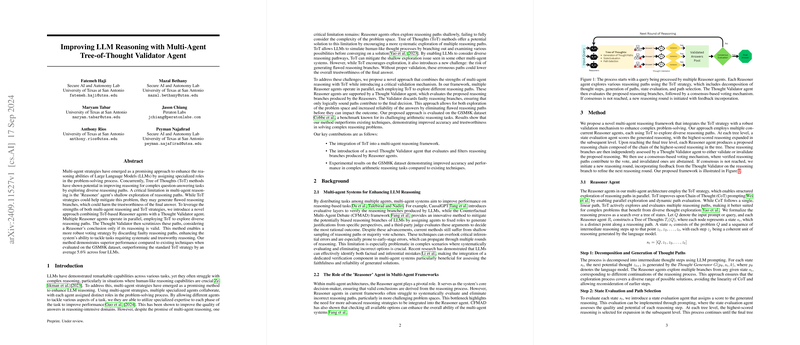Improving LLM Reasoning with Multi-Agent Tree-of-Thought Validator Agent
The paper Improving LLM Reasoning with Multi-Agent Tree-of-Thought Validator Agent discusses an innovative approach aimed at enhancing the reasoning capabilities of LLMs. This research, contributed by authors from the University of Texas at San Antonio and Peraton Labs, integrates multi-agent strategies with the Tree of Thoughts (ToT) method to create a robust reasoning framework. The novel addition of a Thought Validator agent significantly refines the system's performance on complex tasks, specifically arithmetic reasoning, as demonstrated on the GSM8K dataset.
Introduction
LLMs, while powerful, often fall short in tasks requiring intricate reasoning comparable to human thought processes. Multi-agent strategies have emerged as a promising remedy by delegating specific roles to different agents within the framework. Concurrently, ToT methodologies have shown promise by simulating diverse reasoning paths, thereby enabling LLMs to better approximate human-like thought processes. However, ToT's exploratory benefit is often countered by the risk of generating flawed reasoning branches, impacting the final output's reliability.
Methodology
The authors propose a multi-agent architecture where multiple Reasoner agents, each employing the ToT strategy, operate in parallel to explore diverse reasoning paths. To mitigate the creation of logically flawed branches, a Thought Validator agent evaluates and discards invalid reasoning outcomes. This validation mechanism ensures that only sound reasoning paths contribute to the final solution, enhancing both accuracy and trustworthiness.
Core Components:
- Multi-Agent Framework with ToT Reasoner Agents: Each Reasoner agent generates multiple thought paths using the ToT method, branching out from initial premises to explore various possible solutions concurrently.
- Thought Validator Agent: This agent scrutinizes the reasoning branches produced by the Reasoner agents. Each branch undergoes a rigorous evaluation process for logical consistency, factual accuracy, completeness, and relevance to the original query.
- Consensus-Based Voting Mechanism: Validated branches contribute to a consensus-based voting mechanism. If a consensus is not reached, the system enters an iterative refinement phase, incorporating feedback from the Thought Validator to refine the reasoning in subsequent rounds.
Results
The proposed methodology was tested using a subset of the GSM8K dataset, known for its challenging arithmetic problems. The new approach demonstrated superior performance across various LLMs, including versions of OpenAI's GPT and Meta's Llama models. Notably, the framework showed an average improvement of 5.6% over standard ToT strategies.
Table 1, illustrating these results, highlights the following:
| Method | Gpt-3.5-turbo | GPT-4o-mini | Llama3.1-8B | Llama3.1-70B | |--||-|-|--| | Standard IO | 60.0 | 91.2 | 75.4 | 93.0 | | CoT | 68.0 | 89.2 | 76.0 | 89.4 | | ToT | 75.4 | 91.6 | 80.2 | 92.8 | | MA ToT with Thought Validator | 84.2 | 92.2 | 89.0 | 94.8 |
These results reveal the enhanced accuracy of the proposed method, particularly in scenarios where initial approaches (like Standard IO and Chain of Thought) struggled.
Implications
Practical Implications: The combination of ToT with a robust validation mechanism through multi-agent collaboration can be pivotal for applications requiring high reliability in automated reasoning, such as financial modeling, legal reasoning, and complex decision-making in autonomous systems.
Theoretical Implications: This approach opens avenues for further research into optimizing agent-based reasoning structures, examining the balance between computational complexity and reasoning depth. It also suggests exploring dynamic tree structures where the depth and breadth of exploration can adapt based on task complexity.
Future Developments: Subsequent research could focus on reducing the computational overhead associated with ToT, potentially by developing more efficient evaluation metrics or optimizing the branching strategy. Additionally, integrating dynamic adaptability into the tree depth and breadth to balance between performance and computational cost would be a valuable enhancement.
Conclusion
The integration of multi-agent reasoning and the Tree of Thoughts method, augmented with a Thought Validator agent, significantly advances the reasoning capabilities of LLMs. This approach not only addresses the shallow exploration issues but also ensures the reliability of the final outcome by systematically discarding flawed reasoning paths. The promising results on the GSM8K dataset affirm the potential for broader application and further development of this methodology.
